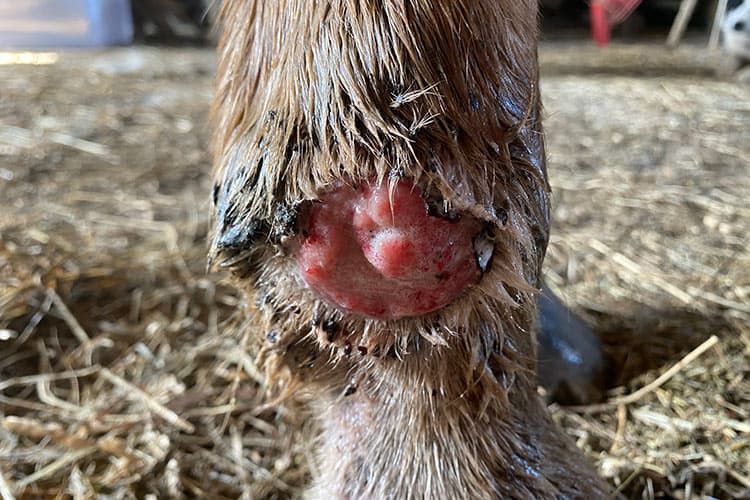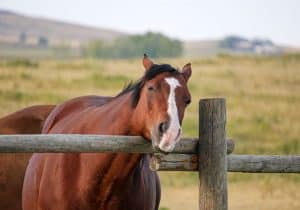Understanding Proud Flesh
- Topics: Article, Horse Care, Injuries & Wounds, Lower Limb, Wound Management

Wounds on horses’ bodies and limbs are exceptionally common. Those on distal (lower—below the knee/carpus or hock/tarsus) limbs are especially difficult to manage, which often leads to the production of proud flesh, or exuberant granulation tissue, resulting in a chronic wound. Early recognition and appropriate treatment are crucial for complete wound healing. Here we’ll explain the wound healing process, appropriate treatment to avoid proud flesh, and what to expect when managing proud flesh with your veterinarian.
How Wound Healing Works
The normal wound healing process includes four stages: hemostasis (clotting), inflammatory (localized swelling), proliferative (rebuilding), and maturation (remodeling). They normally proceed in an organized and linear fashion; however, contamination, infection, inflammation, and motion can halt the progression of healing and lead to chronic wounds.
Proud flesh develops when the normal proliferative phase of the wound healing process proceeds unrestricted. Typically, granulation tissue is pink and appears rough or bumpy. This tissue is highly vascularized but does not contain nerve endings, which means it contains many blood vessels that help supply oxygen to the area but does not have any sensation. Horses are more prone to proud flesh than other species, especially when it comes to wounds on the distal limbs. This predisposition occurs due to the high tissue tension and mobility in these areas. Bandaging and rest are vital to wound healing, as continuous wound movement and contamination cause persistent inflammation, which complicates healing.
Preventing Proud Flesh
Persistent inflammation, along with infection, is a major contributor to proud flesh formation in a wound. Your veterinarian should examine any wound closely and remove foreign material, bone fragments, or dead tissue that can cause inflammation and infection. He or she should also lavage (flush) it immediately, preferably with a balanced saline solution. Once the wound is clean, your vet can apply an appropriate dressing and bandage, the type of which varies on a case-by-case basis.
Consult your veterinarian about any wounds that appear deep or extensive, that lie over important structures like joints and tendons, or that already show signs of proud flesh development. Some cases might require debridement (trimming) of dead tissue or wound closure. Companies advertise many over-the-counter products as proud flesh preventives. Medical-grade honey dressings appear to be extremely effective at providing antibacterial support to healing wounds, while also being very gentle and keeping them moist. Ask your veterinarian what product is best for your situation.
Treating the Issue
Work with your veterinarian to manage proud flesh efficiently and effectively. The first step is determining whether the wound has any lingering infectious or inflammatory constituents. In some cases he or she might need to investigate further through diagnostic imaging.

After addressing possible infection, your veterinarian might suggest treating the proud flesh with topical steroids (e.g., Panalog), surgical debridement, or both, depending on the severity. The goal of topical steroid treatment is to reduce the inflammatory response and, thus, prevent overproduction of granulation tissue.
Surgical debridement is necessary when the proud flesh becomes taller than the normal epithelium (outermost layer of skin tissue) surrounding it. Epithelial cells cannot climb over the mountainous granulation tissue; therefore, when this happens, wound contracture halts. Trimming the granulation tissue down to a healthy wound bed so it’s flush with the surrounding epithelium (followed by bandaging of the area) will encourage appropriate wound healing. Due to the extensive vascular supply and lack of nerve supply, trimming of this tissue will be bloody yet pain-free for the horse. If the wound bed is so large that the skin cannot grow over the area, your veterinarian might recommend skin grafts—a labor-intensive process that typically involves consultation with a surgeon. With early intervention and meticulous care, however, you and your veterinarian can manage wounds at risk for proud flesh development successfully.
Take-Home Message
For the best healing, identify and treat distal limb wounds in horses quickly. Involving your veterinarian in wound evaluation and management is paramount to appropriate and complete wound healing.
Written by:
Allison Haspel, DVM
Related Articles
Stay on top of the most recent Horse Health news with















